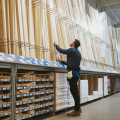The quality of your air and the quality of your life are closely connected. Air quality is tied greatly to health, comfort, and cleanliness inside your home. Therefore it’s a good idea to take steps to ensure that the air in your home is kept clean.

In today’s modern world, there are many pollutants that can end up inside your home. Pet dander and pollen can cause allergic reactions, while combustion pollutants like carbon monoxide can creep into a faulty HVAC system and lead to health problems, including cancer, strokes, and heart attacks. Having clean air means relief for sufferers of allergies and asthma and a reduced risk of colds, flus, and other airborne illnesses. Improved health means an improved mood and money saved on doctors’ bills, as well!
Improving your air quality and keeping it improved requires you to be diligent and proactive. Here are five ways to improve your indoor air quality:
Have your HVAC System Regularly Inspected
Like the plumbing, electricity, and any of the other systems in your home, you need to have your HVAC system inspected regularly. HVAC – which means heating, ventilation, and air conditioning – covers everything from the thermostats to the ducts and they all need to be checked regularly.
Ducts can become leaky or filled with dirt and debris; if your ductwork is dirty, it’s definitely leaking. Thermometers can fail or become inaccurate. Your furnace can lose its efficiency. With so many different parts that need regular maintenance, it’s necessary for you to have an inspection by a heating and air conditioning specialist at least once a year. They will check for any parts that are becoming worn out or malfunctioning and can make all the necessary repairs for you.
In fact, the duct system is just as important as the mechanical HVAC system as leaky ducts and faulty ductwork design causes home air leaks, most commonly coming from the attic, crawlspace, wall insulation, or outside dust. However, there are recommended steps if your ductwork is in need of repair.
First, AeroSeal — which seals the ducts from the inside — is a huge proven money-saver for homeowners as it prevents dust buildup, immediately improving your air quality.
Additionally, global plasma solutions (GPS) and other positively ion-charging devices are great at keeping your ducts clean as they cause the dust and allergen particles to stick together. The particles then become heavy, drop to the ground, and are caught up in the filter.
In similar fashion, UV light, plasma air scrubbers, HEPA filters, all work — often in tandem — to keep your system working efficiently.
However, if it’s been longer than 10 years, you really need a good cleaning in combination with the above solutions.
Regularly Change the Filters
As a part of the routine maintenance on your HVAC system, you should regularly have any and all filters swapped out for new, clean ones. This step alone can make a huge difference in the overall quality of the air in your home; clean filters can catch pollutants, toxins, allergens, pet dander, and other particulate matter that can cause health issues when you are in your home.
Dirty filters, on the other hand, quickly lose their efficiency and the dirt and dust that builds up on them can fill up the home very quickly. When you have your HVAC inspection done, make sure it includes fully replacing all the filters with brand new ones. Look for modern filters; the latest technology allows filters to be incredibly efficient at catching all sorts of pollutants, even very very small ones. Additionally, if you have furry pets in your home, smoke, or have severe allergies or asthma, it’s recommended you replace your filters every month.
Have your HVAC System Upgraded
While some of the HVAC systems in your home can be brought to full efficiency simply through a cleaning or a tune-up, other systems will need to be upgraded fully. If your system is more than 10 years old, you will want to consider having it replaced with a newer one. Modern technology has made leaps and bounds in giving us HVAC systems that are more green, more energy efficient, and cleaner than ever before. Look for systems with the ENERGY STAR rating, which can potentially save you hundreds of dollars over the years due to its improved use of power.

When having a new HVAC system installed, one of the most important considerations is the size of the system. If the system is not properly sized to fit the house, it will not work properly and can even potentially damage your home. If a system is too small, it will not be able to properly circulate air throughout your home. Conversely, if your system is too large, it will not properly dehumidify the home, which can lead to mold growth and other problems. Choosing the right HVAC system is another task that a reputable professional can help you with.
Have an Air Cleaner Installed
Jumping off from the last few steps mentioned in this article, another way you can help to reduce the toxins and mold in your home is to have an air cleaner installed. These air cleaners can be small enough to fit inside of a single room, or they can serve the whole house. Either way, they will provide a great benefit by circulating the air and filtering out all of the dust, allergens, and pollutants as they do so. Not only can they catch larger particulate matter such as pollen, they can also help to purify the air by killing harmful bacteria and reducing your family’s chances of getting sick during cold and flu season. Consult with your HVAC professional and ask about your options regarding air cleaners and air purifiers.
Control the Humidity
Humidity can be a potentially destructive force in your home if it’s not properly kept under control. Consult your HVAC professional about having a humidity gauge installed and check it regularly.
If your humidity falls below 30%, your home has become too dry. If the air is too dry, it can lead to dry skin, nasal congestion, throat irritation, and other problems. If, on the other hand, the humidity rises above 50%, it can lead to the growth of toxic mold. These mold spores can cause allergies and other health problems. If your home becomes too humid, you can reduce it by increasing the airflow using a ceiling fan or simply by opening a window. If your home becomes too dry, you can have a humidifier installed to return some much-needed moisture to the air. Ask about having a humidity gauge installed and, if necessary, a humidifier or dehumidifier.
However, when addressing HVAC needs, it’s important to consider safety, health, comfort, durability, and efficiency simultaneously. This will lead to the best outcome when you are heating and cooling your home. Reach out for further information or to schedule your home performance energy test.




















